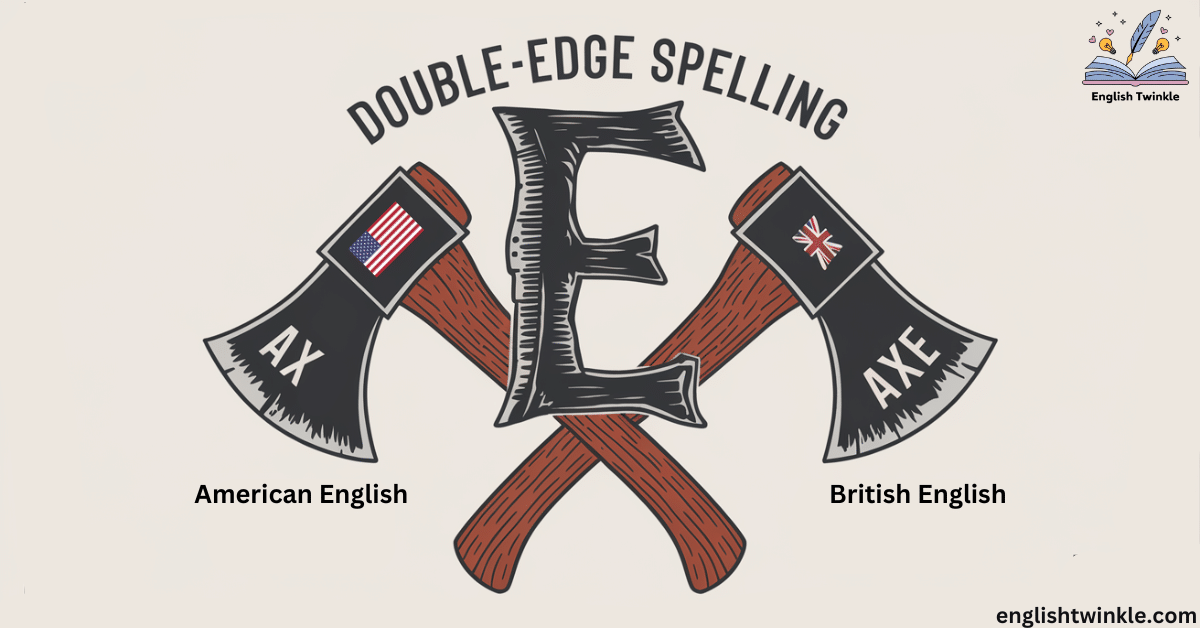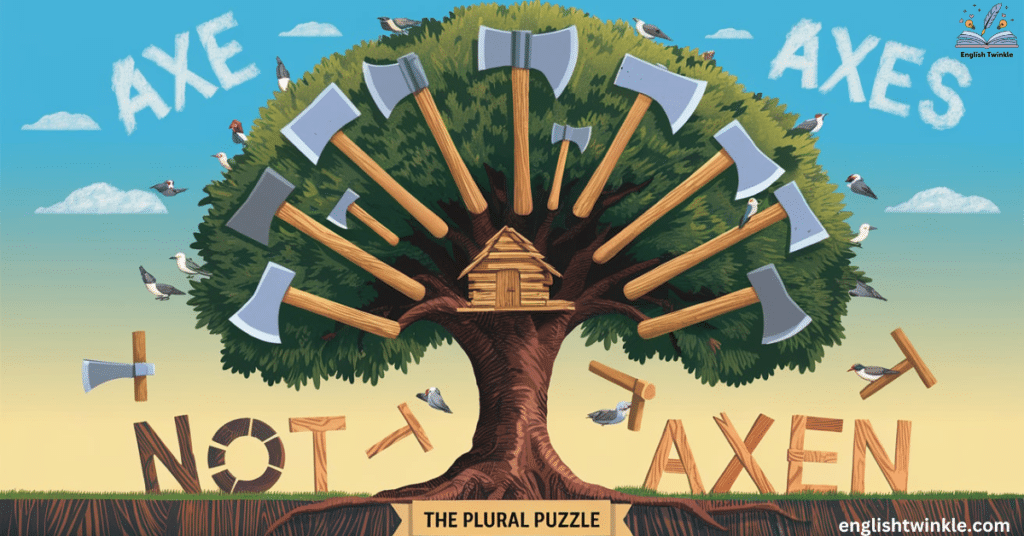In the vast forest of language, even simple words can sometimes leave us lost among the trees. Take the word “axe,” for instance. It’s a tool we’ve all heard of, but when it comes to talking about more than one, things can get a bit… well, thorny. Is it axes or axen? Let’s swing into action and clear the air on this cutting-edge grammar question of Plural of Axe.
What’s an Axe? Chopping Through the Basics
Before we tackle the plural, let’s make sure we’re all on the same page about what an axe actually is. An axe (or ax in American English) is a tool that’s been around for millennia, shaping human history as much as it’s shaped wood.
An axe typically consists of:
- A wooden handle (also called a haft)
- A metal head with a sharp blade on one side
- Sometimes, a hammer head on the opposite side of the blade
But don’t let its simplicity fool you – the axe has played a crucial role in human development. Here’s a quick rundown of the axe’s main uses throughout history:
- Felling trees for construction and fuel
- Splitting wood for easier transport and use
- Shaping wood for various tools and structures
- As a weapon in warfare and self-defense
- In various ceremonies and rituals across cultures
- As a symbol of authority (like the fasces in ancient Rome)
The word “axe” has a rich history, stemming from Old English “æx” or “eax.” This, in turn, comes from Proto-Germanic akwisi, which itself traces back to the Proto-Indo-European root ag-, meaning “to cut.”
The Root of the Matter: Origins of “Axe”
To understand why we pluralize “axe” the way we do, it helps to look at its origins. The word “axe” has deep roots in the English language, dating back to Old English. Here’s a more detailed timeline:
- Proto-Indo-European (around 4500 BCE): *ag- (to cut)
- Proto-Germanic (around 500 BCE): *akwisi
- Old English (450-1066 CE): æx or eax
- Middle English (1066-1500 CE): ax or ex
- Modern English (1500 CE-present): axe (British) or ax (American)
This long history explains why “axe” follows regular English pluralization rules, despite its somewhat unusual spelling. It’s been part of our language for so long that it’s fully integrated into our grammatical patterns.
Sharpening Our Understanding: The Plural of Axe
Now, let’s get to the heart of the matter. The correct plural of axe is axes. This applies whether you’re using the British spelling “axe” or the American spelling “ax.”
But why isn’t it “axen,” you might ask? After all, we have “ox” and “oxen,” right?
The reason is simple: “axe” follows the regular rules for pluralization in English. Most nouns that end in -e, -x, -z, -ch, or -sh form their plurals by adding -es. This rule applies to “axe,” giving us “axes.”
Here’s a handy table to illustrate:
| Singular | Plural | Rule |
|---|---|---|
| box | boxes | Add -es to words ending in -x |
| bush | bushes | Add -es to words ending in -sh |
| axe/ax | axes | Add -es to words ending in -e or -x |
| fox | foxes | Add -es to words ending in -x |
| buzz | buzzes | Add -es to words ending in -z |
| church | churches | Add -es to words ending in -ch |
The word “oxen” is an exception, not the rule. It’s one of the few words in modern English that still uses the Old English -en plural form. Other examples include:
- child → children
- brother → brethren (in certain contexts)
- sister → sistren (archaic)
X Marks the Spot: Nouns Ending in “-x” and Their Plurals
Speaking of words ending in -x, let’s look at a few more examples to cement our understanding:
| Singular | Plural | Notes |
|---|---|---|
| fox | foxes | Regular -es ending |
| box | boxes | Regular -es ending |
| index | indexes/indices | Both forms accepted; “indices” more common in academic contexts |
| matrix | matrices | Irregular Latin plural |
| apex | apexes/apices | Both forms accepted |
| vortex | vortexes/vortices | Both forms accepted |
| complex | complexes | Regular -es ending |
As you can see, most follow the same rule as “axe.” However, some words of Latin or Greek origin (like matrix) have retained their original plural forms, and some have both regular and irregular plurals.
Double-Edge Spelling: Axe vs. Ax

You might have noticed that we’ve been using both “axe” and “ax.” So what’s the deal?
- Axe is the standard British spelling
- Ax is the preferred American spelling
Both are correct, and both pluralize to “axes.” The choice between them often comes down to your audience and personal preference. Here’s a brief history of the spelling:
- Old English: æx or eax
- Middle English: ax or ex
- Modern British English: axe
- Modern American English: ax
Interestingly, “ax” was the more common spelling in both British and American English until the mid-19th century. The “axe” spelling gained popularity in British English in the late 19th century, while American English retained the shorter form.
Wielding Words: “Axe” in Action
To help you get comfortable with using “axe” and its plural form, here are some example sentences:
- “The lumberjack sharpened his axe before heading into the forest.”
- “The museum display featured several ancient axes from different cultures.”
- “She has to grind her ax before the competition.”
- “The firefighters used their axes to break down the door.”
- “The executive took an axe to the budget, cutting costs across all departments.”
- “In the horror movie, the killer wielded a bloody axe.”
- “The archaeologists discovered stone axes dating back to the Neolithic period.”
- “He’s been dying to axe that project for months.”
- “The guitar player’s axe was a vintage Fender Stratocaster.”
- “The company decided to axe 100 jobs in the restructuring.”
Notice how “axes” is used as the plural for both “axe” and “ax,” and how the word can be used as both a noun and a verb.
Beyond the Blade: Related Terms and Concepts
The word “axe” has chopped its way into our language in more ways than one. Here are some related terms and concepts:
- Battle-axe: A type of axe specifically designed as a weapon, often with a longer handle and a head designed for piercing armor.
- Axe-handle: The long handle of an axe, typically made of wood or fiberglass.
- To axe: A verb meaning to cut or remove, often used metaphorically (e.g., “The company axed 100 jobs”)
- Axe head: The metal part of the axe that includes the blade.
- Axe blade: The sharpened edge of the axe head used for cutting.
- Broadaxe: A large axe with a wide blade, used for hewing logs into beams.
- Felling axe: An axe designed specifically for cutting down trees.
- Splitting axe: An axe with a wedge-shaped head, designed for splitting wood along the grain.
- Double-bit axe: An axe with blades on both sides of the head, often with different shapes for different purposes.
- Throwing axe: A smaller, lighter axe designed to be thrown as a weapon or in sport.
Synonyms of Axe
While “axe” is a specific tool, there are several related implements that are sometimes used interchangeably. Here’s a table of synonyms with their meanings and examples:
| Synonym | Meaning | Example |
|---|---|---|
| Hatchet | A small, light axe | “He used a hatchet to split kindling for the campfire.” |
| Adze | A tool similar to an axe but with the blade perpendicular to the handle | “The carpenter shaped the wood beam with an adze.” |
| Cleaver | A heavy knife used for cutting meat | “The butcher used a cleaver to chop through the bone.” |
| Chopper | A general term for a tool used for chopping | “She used a vegetable chopper to quickly dice the onions.” |
| Tomahawk | A light axe traditionally used by Native Americans | “The museum displayed several ornate tomahawks from various cohorts.” |
Each of these has its own specific uses and characteristics, but they all share the basic concept of a bladed tool for cutting or chopping.
Cultural Impact: The Axe in Language and Society

The axe has left its mark not just on trees, but on our language and culture as well. Here are some common idioms and phrases involving axes:
- “To have an axe to grind”: To have a selfish motive for doing something Example: “Don’t trust his advice on this matter; he has an axe to grind with the company.”
- “To take an axe to”: To drastically reduce or eliminate something Example: “The new CEO took an axe to the marketing budget.”
- “To bury the hatchet”: To make peace (the hatchet being a type of small axe) Example: “After years of feuding, the two families finally decided to bury the hatchet.”
- “To get the axe”: To be fired or dismissed Example: “Half the department got the axe in the latest round of layoffs.”
- “To be as sharp as an axe”: To be very intelligent or quick-witted Example: “Don’t try to outsmart her; she’s as sharp as an axe.”
In literature and folklore, axes often play significant roles. Here are a few examples:
- In Norse mythology, Thor’s hammer Mjölnir was originally conceived as an axe.
- The tale of George Washington and the cherry tree (though likely apocryphal) features an axe prominently.
- In “The Shining” by Stephen King, an axe becomes a terrifying weapon.
- Paul Bunyan, the giant lumberjack of American folklore, is always depicted with his trusty axe.
The axe has also made its mark in modern popular culture:
- “Axe” is slang for an electric guitar in musician lingo.
- The body spray brand “Axe” plays on associations of masculinity and sharpness.
- In many video games, axes are popular weapons, often associated with strength-based characters.
The Science of Axes: Design and Function
The design of an axe is a perfect example of applied physics. Here’s how different parts of an axe work together:
- Handle length: Provides leverage, increasing the force of the swing.
- Head weight: Adds momentum to the swing.
- Blade shape: Determines how the axe enters and splits the wood.
- Blade angle: Affects how easily the axe penetrates and how quickly it can be removed.
Different types of axes are designed for specific purposes:
- Felling axes have a thin, sharp blade to cut across wood grain.
- Splitting axes have a wider, wedge-shaped head to split wood along the grain.
- Carpenter’s axes often have a hammerhead opposite the blade for driving nails.
The evolution of axe design over thousands of years reflects human ingenuity and our ability to adapt tools to our needs.
Axes Around the World

Different cultures have developed unique axe designs based on their specific needs and available materials. Here are a few examples:
- Francisca: A throwing axe used by the Franks in the Early Middle Ages.
- Bardiche: A long-handled axe used in Eastern Europe from the 14th to 17th centuries.
- Nzappa zap: A ceremonial axe-knife from the Congo region.
- Ono: A Japanese axe with a shorter handle, designed for use in more confined spaces.
- Tabar: A battle-axe from Persia, often richly decorated.
These diverse designs showcase how the basic concept of an axe has been adapted and refined across different cultures and time periods.
Conclusion: Honing Your Grammar Skills
To wrap things up, let’s revisit the key points:
- The plural of axe is axes, not axen.
- This follows the regular rule for pluralizing words ending in -x.
- Both “axe” (British) and “ax” (American) are correct spellings.
- The word has a rich history and has impacted our language beyond its literal meaning.
- Axes have played a crucial role in human history and continue to be important tools and cultural symbols.
Understanding these nuances not only improves your grammar but also gives you insight into the fascinating world of language evolution and tool development. So the next time someone asks you about the plural of axe, you can confidently say, “It’s axes, and let me tell you why…”
Quiz: Test Your Axe Knowledge
Let’s see how much you’ve absorbed about axes and their linguistic quirks:
- What’s the correct plural of axe? a) Axen b) Axes c) Axies d) Axi
- Which spelling is preferred in American English? a) Axe b) Ax c) Axx d) Axs
- What’s the origin of the word “axe”? a) Latin b) Greek c) Old English d) French
- Which of these is NOT a common use for an axe? a) Felling trees b) Splitting wood c) Cooking food d) Shaping wood
- What does the idiom “to have an axe to grind” mean? a) To sharpen an axe b) To have a selfish motive c) To cut down a tree d) To start a fight
- Which of these words does NOT follow the same pluralization rule as “axe”? a) Box b) Fox c) Ox d) Tax
- In what century did the spelling “axe” become more common in British English? a) 17th century b) 18th century c) 19th century d) 20th century
- What’s a battle-axe? a) A type of military strategy b) A weapon designed for combat c) A tool for chopping vegetables d) A ceremonial object
- Which of these is a synonym for axe? a) Hammer b) Saw c) Hatchet d) Drill
- What does it mean to “bury the hatchet”? a) To hide evidence b) To make peace c) To quit a job d) To fail at a task
Answers: 1-b, 2-b, 3-c, 4-c, 5-b, 6-c, 7-c, 8-b, 9-c, 10-b
Remember, language is a tool just like an axe. The more you understand it, the more effectively you can use it. Keep chopping away at those grammar questions, and you’ll be a language lumberjack in no time!

Freck John, linguist and English educator, shares grammar insights and writing tips at English Twinkle, making language concepts accessible to all learners.







